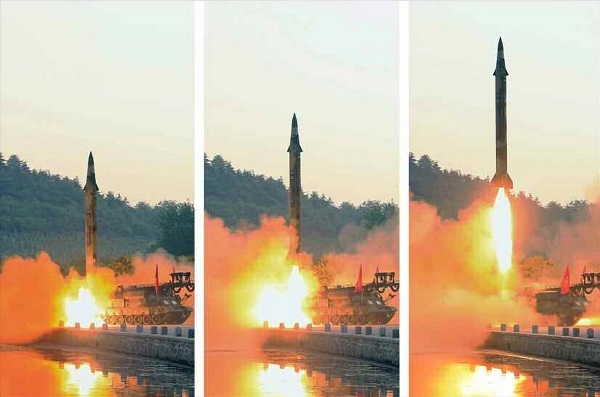With Monday’s missile test, North Korea appeared to have succeeded in developing a new ballistic missile capable of striking South Korean and US warships operating on the peninsula, possibly US aircraft carriers, experts in South Korea said Tuesday.
The North fired what is considered to be a variant of a Scud-type missile from the North’s coastal city of Wonsan on Monday, which flew at least 450 kilometers, according to South Korean military.
The projectile is believed to be the same type of anti-ship ballistic missile revealed at the North’s military parade on April 15. Named “KN-17” by the US government, the missile is capable of targeting aircraft carriers with precision-guidance system.

A ballistic missile using what North Korea called a precision control guidance system is launched on May 29, 2017, in this photo released by the Rodong Sinmun, the North`s ruling party organ, on May 30. (For Use Only in the Republic of Korea. No Redistribution) (Yonhap)
Pyongyang on Tuesday claimed success in the launch, saying the projectile was able to “make ultra-precision strike” through a “precision control guidance system.”
“The ballistic rocket flew toward the east sky where the day broke and correctly hit a planned target point ... after flying over the middle shooting range,” said the regime in a statement released by the Korean Central News Agency, stressing they struck the target with a deviation of only 7 meters.
Military analysts in the South said the precision-guided system would be a “remarkable technological breakthrough,” because it allows the projectile to successfully avoid interception during the re-entry phase and accurately strike a target with its own guidance system.
The North claimed that the test was aimed at “examining the reliability to operate the caterpillar vehicle” and “verifying the technological indices of the new-type precision-guided ballistic rocket capable of making ultra-precision strike” on its enemy’s warships such as a US aircraft carrier.
Although North Korea has yet to obtain other crucial capability needed for attacking moving aircraft carriers, such as surveillance satellites, long-range drones and Over The Horizon radar, the regime can attack South Korean and US warships deployed near a maritime border with the North, the analysts added.
“Since North Korea didn’t have surveillance satellites and other advanced assets, they had faced challenges in employing the ASBM. … But since early 2000, they have accelerated their efforts to develop a sensor designed to increase the accuracy of the missile,” said Chang Young-keun, a missile expert at Korea Aerospace University.
When asked whether North Korea had overcome such technological challenges, the Joint Chief of Staff’s spokesperson Roh Jae-chun said “there was still technological issues,” adding that further analysis is needed to verify the North’s claim.
Since the beginning of this year, North Korea has boasted advanced missile capability by firing a total of nine missiles with diverse capabilities in engine and range. Among them were the medium-range, solid-fueled Pukguksong-2 and the intermediate-range, liquid-fueled Hwasong-12.
By Yeo Jun-suk (jasonyeo@heraldcorp.com)






